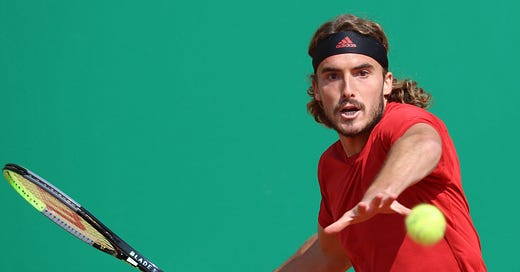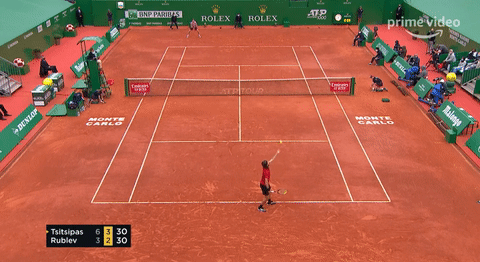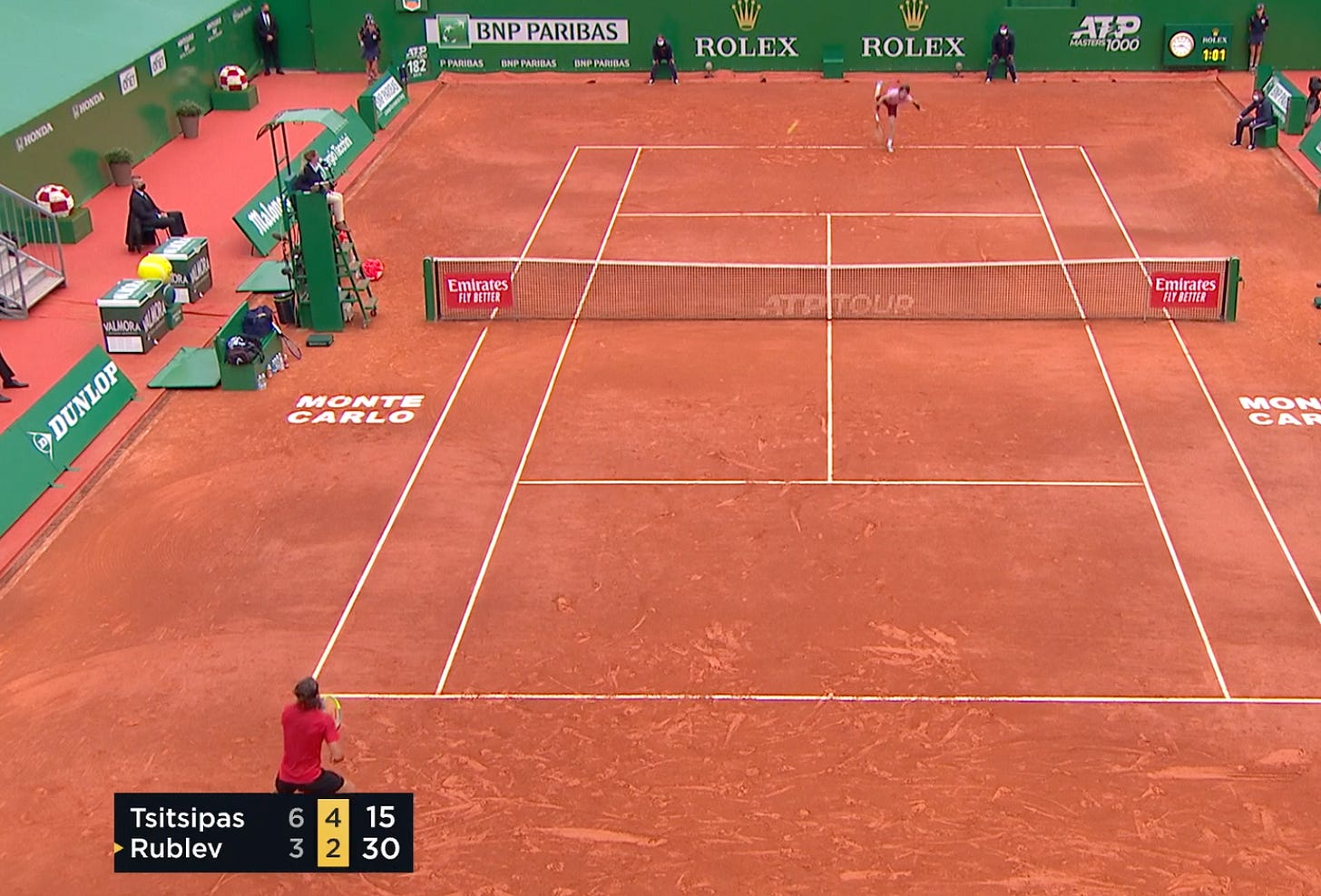Monte Carlo Final - Tsitsipas vs Rublev
Analysis - Tsitsipas finds his strengths and deprives Rublev of his
Tsitsipas d Rublev: 6-3, 6-3
A one sided, yet still interesting match. The keys today were:
Who created more free or easy points on serve
Who got to hit more forehands
Tsitsipas absolutely dominated in both (related) categories.
Both players had good performances on first serve, finishing with 80%+ of points won when they landed that first delivery. Tsitsipas managed 44% unreturned first serves compared to Rublev’s 33%, and some big aces and un-returnables certainly made the Greek’s life easier today. But much more importantly it was the 2nd serve and 2nd serve return performances which truly separated the two players. Not only did Tsitsipas manage an impressive 21% unreturned 2nd serves, but Rublev only mustered an extremely measly 4% in comparison. Nearly every single time Rublev had to hit a second serve the rally either developed with an advantage for Tsitsipas or, at worst, from neutral. Much of this was because of how regularly Tsitsipas managed to hit his forehand when returning Rublev’s 2nd serves, and conversely how well Tsitsipas managed to force Rublev to hit his backhand on many 2nd serve returns.
Serve +1
Both these players want to get their forehands into play as early and aggressively into the point as possible, so let’s take a look at both of their serve +1 performance.
— NB: Serve +1 is the shot the players hit to follow up their serve —
(these numbers are from any time the returner put the ball in, charted by me)
As you can see in the green column, both managed to overwhelmingly play their forehand when they landed their first serves, contributing to that 80%+ 1st serve points win rate for both. But their fates diverged clearly on 2nd serve (orange column): when Tsitsipas had to play a 2nd serve and the point developed, he was only forced to play a backhand as his serve +1 shot four times in the match. In stark contrast, Rublev had to play 16(!) backhands as his serve+1 after hitting his 2nd serves. No surprises then that Tsitsipas managed to win 68% of his 2nd serve points compared to Rublev’s 33%.
Returns
So what was happening on these 2nd serve returns?
Not including unreturned serves, Tsitsipas managed to hit his forehand 91% of the time when returning a Rublev 2nd serve. Rublev managed to hit just 38% forehands in the same situation. Given both players significantly favour their forehands, the fact that Tsitsipas was able to hit so many more of his preferred shot than Rublev, especially early in the points, was always going to make life very difficult for the Russian.
How did this happen?
Firstly, Tsitsipas’ 2nd serve (101mph) averaged 14mph faster than Rublev’s (87mph avg), meaning it was much harder for Rublev to attack it and/or run around it and hit his forehand — Tsitsipas averaged 79mph on his 2nd serve returns compared to Rublev’s 72mph. Secondly, Tsitsipas’ serve placement, both kickers down the T on the deuce side and out wide on AD side, were significantly more accurate and offensive than Rublev’s. Here’s a good example on what was quite a big point — 30-30 at 3-2* in the 2nd set.
Tsitsipas’ (near end in red) hits an extremely good 2nd serve, right down the T to force Rublev to hit a backhand return and ensure Tsitsipas got to hit a forehand and start the point on his terms. This was a recurring theme.
In stark contrast, and in what was perhaps the most important and repeating pattern of the match, here are a run of three Rublev 2nd serves in a row at the start of the 2nd set. Notice how each one of them are slow enough and central enough for Tsitsipas to run around the backhand and hit his forehand as a return, negating Rublev’s serving advantage and forcing the Russian to play backhands as his serve +1:
The last one, on break point, was a poor error from Rublev, but these three points were microcosms for the match overall. Tsitsipas was the far more likely of the two to get his forehand in play early and aggressively on return. The Greek was never worried that Rublev was going to be able to mix in a faster 2nd serve down the T to catch him out — Tsitsipas’ camping position, in the tramlines betting on a slow kick serve out wide, was a great indication of this:
Not only did Tsitsipas manufacture opportunities to hit his forehand strength far, far more often than Rublev throughout the match — Tsitsipas hit 130 forehands and 100 backhands today, Rublev hit 113 forehands and 121 backhands — but when forced to hit his backhand the Greek was also much more solid than Rublev defensively. Rublev’s flatter backhand means that he doesn’t have the same margin for error as Tsitsipas does on clay with his great, looping backhand giving him plenty of safety.
Avg net clearance in centimetres:
Tsitsipas forehand: 91cm
Tsitsipas backhand: 97cm
Rublev forehand: 64cm
Rublev backhand: 68cm
Avg spin rate (revolutions per second):
Tsitsipas : 55rps on forehand
Tsitsipas 46rps on backhand
Rublev 49rps on forehand
Rublev 32rps on backhand
The Tsitsipas backhand net clearance and spin in particular, when compared to Rublev, made the times when both players had to lean on their slightly weaker wing much higher margin and more sustainable for Tsitsipas, and much riskier for Rublev.
Tsitsipas’ net clearance on both his groundstrokes is one of most effective arrows in his quiver when playing on the red stuff.
I just wrote a whole piece on why flatter hitters can have it more difficult on clay here.
TL;DR:
Today Tsistipas masterfully manufactured opportunities to lean on his own strengths, while also depriving Rublev of similar opportunities. I have absolutely no doubt that Rublev looked rather tired after his heroics earlier this week (upsetting Nadal most of all). He can certainly play better than he did today and the Russian should hopefully take plenty of positives from the first big clay tournament of the year, regardless of this being a rather tough matchup for him on this surface at this point in their careers. But Tsitsipas was a thoroughly deserving winner today, and in the process he got to show everyone why his upside on clay is so exciting, with what will probably be the first of many Masters 1000 titles.
Until next year Monte Carlo (hopefully with fans)…
See you next week for Barcelona Stuttgart, Belgrade & Istanbul.
— MW
Twitter @MattRacquet
If you have any questions about what you just read you can leave a comment below and I’ll answer it. No question is dumb.
All Sunday Final’s analysis issues are free for this month only, but if you want to make sure you don’t miss them you can subscribe here:
// Looking for more?
Daniil Medvedev Does *Not* Like The Clay - Do Flatter Hitters Have it Harder On Clay? https://theracquet.substack.com/p/daniil-medvedev-does-not-like-the
The Modernisation Of Tennis: https://theracquet.substack.com/p/the-modernisation-of-tennis
Federer, Nadal & Djoković Rivalry Impact: https://theracquet.substack.com/p/federer-nadal-and-djokovic-make-a
Tennis Pontificates About Format Changes Again: https://theracquet.substack.com/p/here-we-go-again
Tennis’ Identity Crisis: The Umpire Problem https://theracquet.substack.com/p/tennis-identity-crisis
Analysis of the Djoković Medvedev Australian Open Final: https://theracquet.substack.com/p/the-racquet-micro-not-macro-match
Analysis of the Nadal Medvedev US Open Final Final: https://theracquet.substack.com/p/the-racquet-the-5th-set












Great write-up. Thanks.
Two things I'd love to see about this match, and match-up. Which is not to say you have to provide the answers, or should have:
• In 2009 I watched delPo and Soderling at the O2 in the ATP Finals, and realized that both of them want to play from within 3' or 4' *inside* the sidelines. Of course everyone wants to do the same, but their games are (were) built around that more than many others. Rublev is more mobile than either of those two, but his preferred style of point is similar imo. I don't know that it's available, but it'd be very interesting to see where he was on the court when he lost points vs when he won them. I suspect we'd see him with a higher % of losing points when stretched out to the coasts, but of course I could be wrong. (This is the benefit of hard data, which it's great that you provide, vs seat of the pants assessments like mine.) A corollary to that would be the relative mobility of Rublev vs Tsitsipas; would love to see who ran the greater distance.
• In a similar vein re data from Hawkeye (or FoxTenn, if it can do that), it would be interesting (again) to know the two players' winning/losing percentage at the net. I could not find it at the tournament/ATP match stats.
Thanks